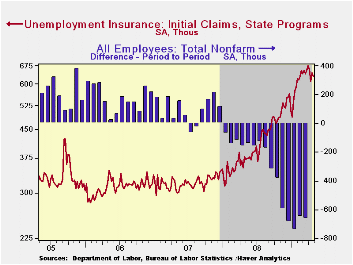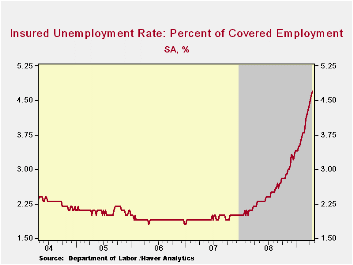 Global| Apr 30 2009
Global| Apr 30 2009U.S. Initial Claims for Jobless Insurance Fall As Continuing Claims Reach Another Record
by:Tom Moeller
|in:Economy in Brief
Summary
In what may be a sign that the worse for the U.S. job market has passed, initial claims for unemployment insurance fell last week and they have moved slightly lower since the March high. Claims fell to 631,000 from a little revised [...]

In what may be a sign that the worse for the U.S. job market has passed, initial claims for unemployment insurance fell last week and they have moved slightly lower since the March high. Claims fell to 631,000 from a little revised 645,000 during the prior period and the April average of 637,000 is down from 658,000 during March. Despite the modest improvement, claims remain near the ten-year high. The four-week average of claims fell to 637,250, the lowest level since late February.
If the pace of worker layoffs has slowed, rehiring of unemployed workers has not picked up. Continuing claims for unemployment insurance increased to a record high of 6,271,000 are remain twice the year ago level. The series dates back to 1966. The four-week average of continuing claims also rose to another record of 6,076,000. Continuing claims provide some indication of workers' ability to find employment and they lag the initial claims figures by one week.
The Labor Department indicated that the largest increases in initial claims for the week ending April 18 were in California (+8,535), New York (+6,959), Connecticut (+3,086), Georgia (+3,056), and North Carolina (+2,983), while the largest decreases were in Pennsylvania (-7,799), Florida (-7,208), Illinois (-3,803), Ohio (-3,310), and Washington (-2,432).
Despite any marginal improvement in the job market, the insured rate of unemployment which follows the continuing claims figures rose yet again to 4.7%. That level was double last April and the highest level since 1983. During the last ten years there has been a 93% correlation between the level of the insured unemployment rate and the overall rate of unemployment published by the Bureau of Labor Statistics.Clearly, the latest weekly figure understates labor market distress in some states. The highest insured unemployment rates in the week ending April 11 were in Michigan (8.0 percent), Oregon (7.7), Pennsylvania (6.7), Wisconsin (6.7), Idaho (6.6), Nevada (6.3), Vermont (6.0), Rhode Island (5.9), Alaska (5.8), Illinois (5.7), and New Jersey (5.7).
The unemployment insurance claim data is available in Haver's WEEKLY database.Do U.S. Consumers Really Benefit from Payment Card Rewards? from the Federal Reserve Bank of Kansas City is available here.
| Unemployment Insurance (000s) | 04/25/09 | 04/18/09 | 04/11/09 | Y/Y | 2008 | 2007 | 2006 |
|---|---|---|---|---|---|---|---|
| Initial Claims | 631 | 645 | 613 | 66.9% | 420 | 321 | 313 |
| Continuing Claims | -- | 6,271 | 6,138 | 107.4% | 3,342 | 2,552 | 2,459 |
Tom Moeller
AuthorMore in Author Profile »Prior to joining Haver Analytics in 2000, Mr. Moeller worked as the Economist at Chancellor Capital Management from 1985 to 1999. There, he developed comprehensive economic forecasts and interpreted economic data for equity and fixed income portfolio managers. Also at Chancellor, Mr. Moeller worked as an equity analyst and was responsible for researching and rating companies in the economically sensitive automobile and housing industries for investment in Chancellor’s equity portfolio. Prior to joining Chancellor, Mr. Moeller was an Economist at Citibank from 1979 to 1984. He also analyzed pricing behavior in the metals industry for the Council on Wage and Price Stability in Washington, D.C. In 1999, Mr. Moeller received the award for most accurate forecast from the Forecasters' Club of New York. From 1990 to 1992 he was President of the New York Association for Business Economists. Mr. Moeller earned an M.B.A. in Finance from Fordham University, where he graduated in 1987. He holds a Bachelor of Arts in Economics from George Washington University.






